
The stamen is the pollen-producing reproductive organ of a flower. Collectively the stamens form the androecium.
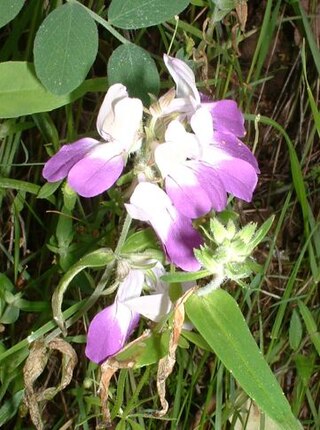
Collinsia is a genus of about 20 species of annual flowering plants, consisting of the blue eyed Marys and the Chinese houses. It was traditionally placed in the snapdragon family Scrophulariaceae, but following recent research in molecular genetics, it has now been placed in a much enlarged family Plantaginaceae.

Collinsia heterophylla, known as purple Chinese houses or innocence, is a flowering plant native to California and the Peninsular Ranges in northern Baja California.
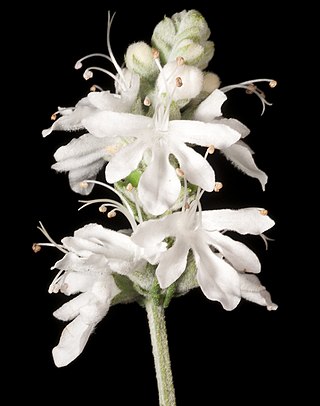
Teucrium is a cosmopolitan genus of flowering plants in the family Lamiaceae, commonly known as germanders. Plants in this genus are perennial herbs or shrubs, with branches that are more or less square in cross-section, leaves arranged in opposite pairs, and flowers arranged in thyrses, the corolla with mostly white to cream-coloured, lobed petals.
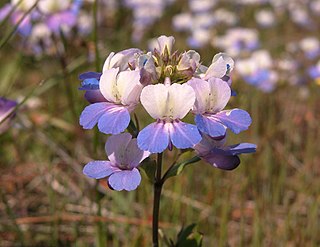
Collinsia grandiflora is a species of flowering plant in the plantain family known by the common names giant blue eyed Mary and large-flowered collinsia. This wildflower is native to western North America from British Columbia to northern California where it grows in coniferous understory and woodland.
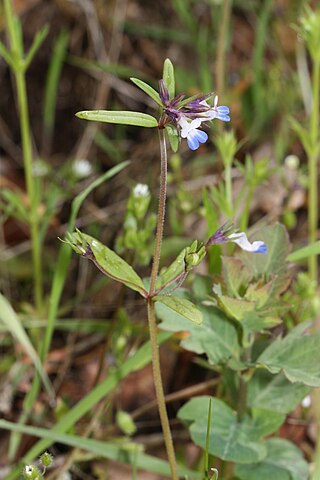
Collinsia parviflora is a species of flowering plant in the family Plantaginaceae known by the common names maiden blue eyed Mary and small-flowered collinsia.

Collinsia parryi is a species of flowering plant in the plantain family known by the common name Parry's blue eyed Mary. It is endemic to central and southern California, where it is found in the southern Coast Ranges and in the Transverse Ranges north and east of Los Angeles.

Collinsia callosa is a species of flowering plant in the plantain family known by the common name desert mountain blue-eyed Mary. It is endemic to California, where it grows in the mountains of the southernmost Sierra Nevada, the Transverse Ranges, and the mountains of the Mojave Desert region. It grows in desert scrub, chaparral, and woodland habitat on the mountain slopes.

Collinsia childii is a species of flowering plant in the plantain family known by the common name Child's blue-eyed Mary.

Collinsia concolor is a species of flowering plant in the plantain family known by the common name Chinese houses.
Collinsia corymbosa is a species of flowering plant in the plantain family known by the common name round-headed Chinese houses. It is endemic to the coastline of California north of the San Francisco Bay Area, where it is uncommon and scattered. Its habitat is the sand dunes of the immediate coastline. This is an annual herb producing a scaly, hairy, red to reddish green stem which grows upright or decumbent to a maximum length of about 25 centimeters. The thick, sparsely hairy leaves are rippled and lobed along the edges, which may be somewhat turned under. The inflorescence is a dense whorl of several distinctive flowers. Each has a hairy calyx of lobed reddish sepals and a corolla up to about 2 centimeters long. The flower has two small upper lobes and three longer lower lobes which come together in a nearly tubular shape. It is generally white with a light purple tint. The smaller upper lobes curl back and dry to brown at their lips.
Collinsia greenei is a species of flowering plant in the plantain family known by the common name Greene's blue-eyed Mary.
Collinsia linearis is a species of flowering plant in the plantain family known by the common name narrowleaf blue-eyed Mary.
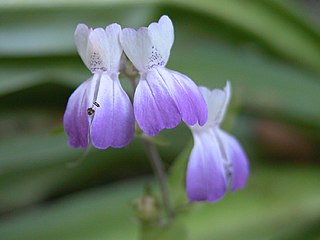
Collinsia multicolor is a species of flowering plant in the plantain family, known by the common names San Francisco blue eyed Mary and San Francisco collinsia. It is endemic to the San Francisco Bay Area, where it is known from San Francisco to Santa Cruz. As of 2008 there are 22 known occurrences. Populations south of Santa Cruz have been extirpated.
Collinsia rattanii is a species of flowering plant in the plantain family known by the common name sticky blue-eyed Mary. It is native to the coniferous forests of the Pacific Northwest of the United States from Washington to northern California. It is an annual herb growing up to 40 centimeters tall with linear leaves rolled under along the edges. The leaves are hairy on the upper surface and hairless and purple-tinted underneath. The inflorescence is coated in sticky glandular hairs. It has a series of nodes from which arise one to five flowers each on pedicels. The flower is only 4 to 8 millimeters long, with two mostly white upper lobes and three mostly purple lower lobes.

Collinsia sparsiflora is a flowering plant in the family Plantaginaceae known by the common names spinster's blue-eyed Mary and few-flowered collinsia. One variety of the species is native to the West Coast of the United States as far north as Washington, while the other three varieties are limited to California alone.

Collinsia tinctoria is a species of flowering plant in the family Plantaginaceae known by the common names sticky Chinese houses and tincture plant.

Collinsia torreyi is a species of flowering plant in the plantain family known by the common name Torrey's blue-eyed Mary. It is native to California and adjacent sections of Oregon and Nevada, where it grows in the coniferous forests of several mountain ranges, including the Sierra Nevada.

Collinsia verna, or blue-eyed Mary, is a winter annual that is native to the eastern and central parts of North America but has become endangered in the states of New York and Tennessee. The flowers are bicolored white and blue. It is a plant of valley bottoms and moist bottom slopes, in areas with moderate lighting and requires some shade.
Blakiella is a monotypic genus of flowering plants in the family Asteraceae, containing the single species Blakiella bartsiifolia. It is native to northeastern South America, where it occurs in Colombia and Venezuela.
This page is based on this
Wikipedia article Text is available under the
CC BY-SA 4.0 license; additional terms may apply.
Images, videos and audio are available under their respective licenses.















